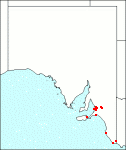Family: Asteraceae
Senecio angulatus
Citation:
L.f., Suppl. 369 (1782).
Synonymy: Not Applicable Common name: Cape ivy.
Description:
Glabrous perennial, erect or scrambling to 2-3 m, branching; stem cylindrical, striate; leaves coriaceous or fleshy; petioles 1-3.5 cm long; blade palmately veined, rhombic to ovate to broadly deltoid, 3.5-5 x 1.5-3.5 cm, distantly toothed, sometimes basally lobed.
Inflorescence a terminal cymose corymb or panicle of usually 8-12 capitula, subdichotomous, branches diverging at 30º-45º, of near-equal length; involucre obconical, 5-7 x 3-4 mm; bracts 7 or 8; calyculus of 3 or 4 linear bracteoles 1-2 mm long; ray florets 4-6, usually 5; ligules 7 x 4 mm, 4-nerved; disk florets 10-15.
Achene 2.2 x 0.5 mm, light-brown with scattered erect short hairs; pappus uniform, deciduous.
|
|
Distribution:
|
Cultivated in Adelaide suburbs, apparently escaping from cultivation in Mount Gambier and possibly elsewhere. Probably best considered as persistent after cultivation, rather than naturalised (pers. comm. D. E. Symon) but with a potential for becoming established.
S.Aust.: MU, SL, SE. Vic. New Zealand, established on the North Island; native of South Africa.
|
Conservation status:
native
Flowering time: April — Sept.
|

SA Distribution Map based
on current data relating to
specimens held in the
State Herbarium of South Australia
|
Biology:
Thought to have been a cause of horse-poisoning in Mount Gambier.
Author:
Not yet available
|

